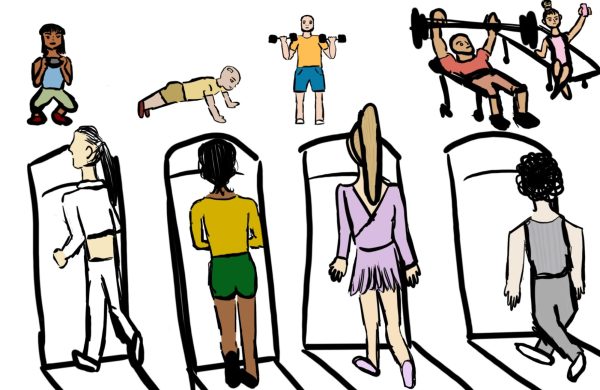Running on what?
Runners share tips, techniques, and habits for a successful run.
Caught up in the chaos and stress of school, looking for a good exercise to keep you in shape, or searching for a way to improve your condition during the fall sport season? The answer to these questions is running. However, what habits, actions, and techniques improve the overall results of running?
The success of a run begins in preparation. There are many actions runners take the night before running. Stretching and rolling out leg muscles to prevent tight muscles, hydrating to avoid cramping, and eating carbohydrates to provide energy to the body are some examples of techniques to perform for a successful run.
“I make sure to eat pasta and chicken the night before a meet,” said freshman cross country runner Mikey Schumacher.“I also recommend about 7-9 hours of sleep.” Sleep is an essential element of preparing the body for a run.
The morning of a run, runners recommend a healthy, satisfying breakfast for energy before the run and to hydrate the morning of a run.
“You have to hydrate before you run! Because if you don’t hydrate, your body won’t be ready to run,” said sophomore cross country runner Katie Castelli. “Also, fuel your body with healthy food that will give you energy.”
Throughout the morning, complete a series of static stretches. About 15- 30 minutes before the run start some dynamic stretches, such as high-knees.
When beginning a run, find a pace that can be kept during the entire duration. This will vary from person to person. There are other techniques that help the overall success of the run.
“Breathe in through your nose and out through your mouth, and try to keep your breathing constant,” said Schumacher. “Try to keep extra movements to minimum to conserve energy.” Another encouraged technique is arm pumping because it helps propel the body forward.
During a run, growing tired is natural, however, do not stop.
“I would prefer my runners to slow down than quit,” said Wayne Edelman, the coach of boys cross country for twelve years. “We never quit.”
After a run, a cool down of a light jog and dynamic stretches is necessary to prevent injuries. Using a foam roller to roll out muscles is encouraged as well.
“Have something to recover – chocolate milk works best,” said Schumacher.
Runners also follow a certain diet that is healthier than the average diet.
“Always fuel your body with food that will give you plenty of energy,” said Castelli.
The ideal diet is to receive 60 percent of energy from carbohydrates, 25 percent from fat, and 15 percent from fat. For larger meals, look for foods like eggs, potatoes, chicken, beans, and pasta. When eating a snack, try to consume fruits, smoothies, low-fat granola bars, and vegetables.
“Stay away from prepared foods, fast food, stuff like that,” said Coach Edelman.
This diet would be ideal for other sports such as soccer and swimming because building stamina is an important aspect of both.
Running long-distance also improves the body’s condition and stamina. This allows athletes to practice and play longer without fatigue. Running is an ideal workout that assists performance in most sports, not just cross country.
By following the habits, completing the actions, and using the techniques, the cross country team has excelled early in the season. The boy’s team placed top three in their first two meets. With two strong freshman, the girls team placed second in both.
“The girls cross country team should be very good this year,” said Castelli.
For students not in a sport, running still provides great benefits. The exercise works out leg muscles such as the hamstrings, quadriceps, hip flexors, gluteals, and calves. Running strengthens core, mid-section, and upper body muscles as well. Also, school and homework can be immense. When feeling stressed or overwhelmed, running provides a great outlet.
“Running is a great stress relief,” said Schumacher.
Running causes a chemical reaction in the brain that releases endorphins which are hormones that dull pain and release a positive feeling throughout the body. Therefore, running will motivate students to work on homework and put them in a better, cheerful mood.
The next time high school feels overwhelming, an exercise is necessary, or searching for a way to improve your condition, go for a run!
Your donation will support the student journalists of Saint Viator High School. Your contribution will allow us to purchase equipment and cover our annual website hosting costs.




